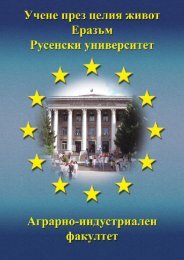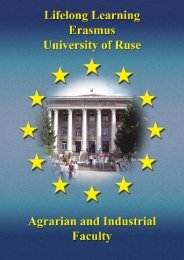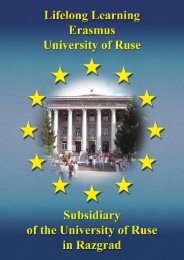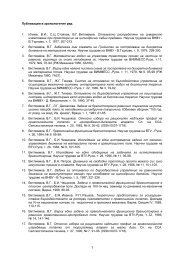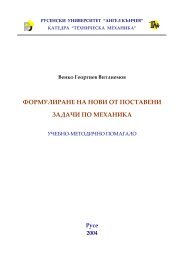Erasmus ECTS Information Package
Erasmus ECTS Information Package
Erasmus ECTS Information Package
Create successful ePaper yourself
Turn your PDF publications into a flip-book with our unique Google optimized e-Paper software.
<strong>Erasmus</strong> <strong>ECTS</strong> <strong>Information</strong> <strong>Package</strong><br />
Faculty of EEEA<br />
3109 Pulse and Digital Devices<br />
<strong>ECTS</strong> credits: 5<br />
Weekly classes: 3lec+0sem+0labs+2ps<br />
Assessment: exam<br />
Type of exam: written test<br />
Department involved:<br />
Department of Telecommunications<br />
Faculty of Electrical Engineering, Electronics and Automation<br />
Lecturers:<br />
Assoc. Prof. Nina Vasileva Bencheva, MEng, PhD, Dept. of Telecommunications, tel.: 888 823, 888 677<br />
E-mail: nbencheva@ecs.uni-ruse.bg<br />
Assoc. Prof. Yoana Emilova Ruseva, MEng, PhD, Dept. of Telecommunications, tel.: 888 823, 888 677,<br />
E-mail: iruseva@ecs.uni-ruse.bg<br />
Principal Assistant Professor Volodia Hristov Tsonev, MEng, Dept. of Telecommunications, tel.: 888 677,<br />
E -mail: vol@uni-ruse.bg<br />
Abstract:<br />
The subject has the objective to familiarize students with the main problems of digital electronics. It links the<br />
functions of digital elements with their microelectronic basis on one hand, and on the other hand – with their<br />
application when building pulse and digital devices. Profound knowledge of electrical engineering and<br />
semiconductors is a prerequisite for the course. The subject helps to give knowledge in the field of hardware.<br />
Course content:<br />
Boolean algebra. Synthesis and analysis of combinational circuits. Digital circuits with memory. Forming circuits.<br />
TTL integrated circuits. CMOS logic integrated circuits. Triggers. Schmidt triggers. Multi-vibrators. Generators of<br />
linear voltage. Impulse circuits with operating amplifiers. Particularities of integrated circuits with middle scale of<br />
integration. Interface circuits.<br />
Teaching and assessment:<br />
The lectures give the students the opportunity to get acquainted theoretically with the main aspects of digital<br />
electronics before the laboratory exercises. The students must be prepared for each practice session and at the<br />
end prepare a report for each of them. The exam is held as a written test.<br />
3070 Computer Organization<br />
<strong>ECTS</strong> credits: 6<br />
Weekly classes: 3lec+0sem+0labs+2ps+1cw<br />
Assessment: exam<br />
Type of exam: written and oral<br />
Department involved:<br />
Department of Computing<br />
Faculty of Electrical Engineering, Electronics and Automation<br />
Lecturers:<br />
Prof. Angel Sotirov Smrikarov, MEng, PhD, Dept. of Computing, tel.: 888 249, 888 743<br />
E-mail: ASmrikarov@ecs.uni-ruse.bg<br />
Abstract:<br />
The objective of the Computer organization course is for the students to familiarize themselves with the arithmetic<br />
and algorithmic fundamentals of computer circuitry and most of all - with the structure and way of operation of the<br />
CPU. The following is considered in details: structure and way of operation of arithmetic and logic unit, control unit,<br />
registers, RAM, cache, interrupt system. Modern RISC and CISC/RISC processors are analysed in detail<br />
The course is linked to the following subjects: Analysis and Synthesis of Logic Circuits, Microprocessors,<br />
Computer Peripherals, Computer Architectures, etc.<br />
Course content:<br />
Arithmetic basis – counting systems, arithmetic computations, presentation and coding of numeric, character and<br />
logic data. CPU - definition, classification, main components. Structure of arithmetic and logic units. Structure of<br />
control units. Memory structure – registers, cache, RAM. Structure of interrupt systems. Example RISC and<br />
CISC/RISC processors.<br />
Teaching and assessment:<br />
At the lectures the students are familiarized with the theoretic aspects of the structure and ways of operation of<br />
different CPU components. At the practice sessions, hardware and software models of main processor units and<br />
blocks are explored.<br />
193



